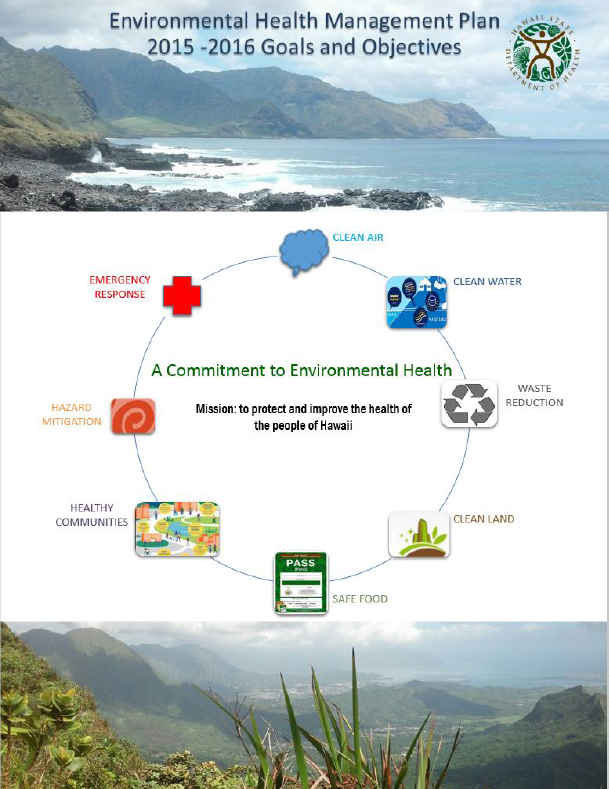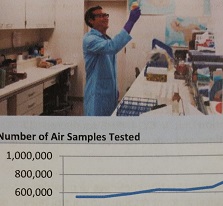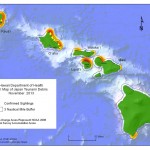Environmental Planning Office
The Environmental Planning Office (EPO) closed effective May 2, 2018. Due to federal EPA funding reductions, the office is no longer providing services. The information posted here will temporarily remain in place for public reference. For Standard Comments, please see the EPO Land Use Planning Review webpage or contact the appropriate Environmental Health Administration branches and offices directly using DOHEHALandUseContactList_20250917.pdf.
~~~~~~~~~~~~~
The Environmental Planning Office (EPO) provides risk-based strategic planning services for pollution prevention and control programs under the direction of the Deputy Director for Environmental Health. Strategic planning functions include developing and coordinating both short and long term environmental program strategies, and ensuring that they are compatible with federal and state environmental laws, regulations, and policies.
EPO reviews and responds to some proposed land use projects; assists with developing program goals and performance indicators; coordinates with county, federal, and other state agencies; provides liaison services for legislative activities; and develops specialized environmental health maps to facilitate well informed decision-making. Our interdisciplinary, environmental health programs are enumerated below. To learn more about the Office, visit our About page. If you have any inquiries or comments, please contact us.
EPO Programs and Activities
 |
Strategic Planning and CoordinationEPO assists with the development of the Environmental Health Administration (EHA) strategic plan, and its communication, coordination, and implementation. EPO’s purview also includes internal planning documents that shape the strategic plan, including EPA grant work plans. |
 |
Land Use Planning and ReviewEPO reviews and communicates DOH evaluations of proposed developments in Hawaii, focusing on large projects that can substantially affect environmental health. Downloadable standard comments are available to assist applicants in preparing environmental impact statements and assessments. |
 |
Environmental Health Management ReportConsistent with the State Strategic Plan and the DOH Strategic Plan, the EPO compiles the ‘Environmental Health Management (EHM) Report’ annually. This comprehensive report covers a wide array of environmental goals, strategies and monitoring metrics. The EHM Report also describes the structure and duties of DOH Environmental Health Administration and its constituent branches and offices. |
 |
Environmental IndicatorsEPO gathers data from the various DOH Environmental Health branches and offices. Our environmental indicators summarize DOH’s environmental monitoring and sampling efforts, as consistent with federal standards. |
 |
Legislative AffairsEPO coordinates with all branches and offices under the DOH Environmental Health Administration (EHA) on relevant legislation reviewed. Pertinent measures are analyzed and delegated according to subject matter and jurisdictions, according to existing state laws and statutes. |
 |
Climate ChangeClimate change is having broad-reaching effects state-wide and world-wide. Various DOH Programs are taking climate change into account as they move forward with their work. The EPO Office Manager participates in the intergovernmental committee on adaptation to climate change (ICAC) and a task force lead by the Hawaii Public Health Association (HPHA). |
 |
Public AffairsEPO helps disseminate information about DOH-EHA programs and recommendations for the public. |
Environmental JusticeEPO assists DOH in promoting health equity and environmental justice (EJ). As resources allow, EPO facilitates EJ projects. |
|
 |
Environmental Geographic Information SystemThe EGIS is a computer-based, environmental Geographic Information System used in planning, data analysis, and the creation of maps. This program provides services to DOH-EHA and the EPA. Some EGIS data is incorporated into the State Environmental Health Warehouse (EHW). |
Last update: 09/17/2025 (first paragraph only)